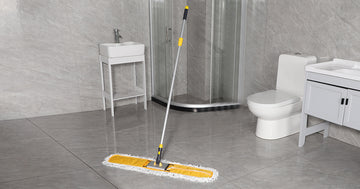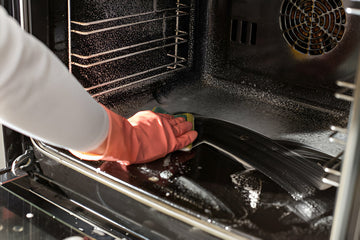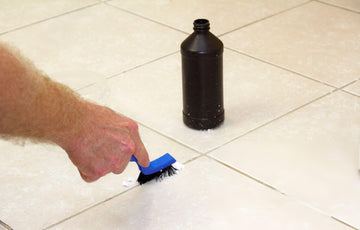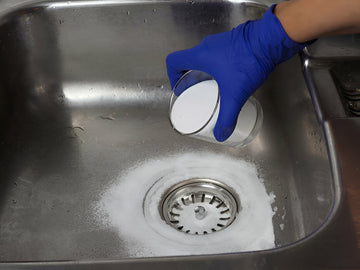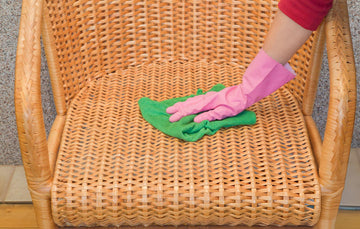Tile floors are a popular choice for homeowners due to their durability, aesthetic appeal, and ease of maintenance. They offer an impressive variety of colours, shapes, and sizes, making it easy to find the ideal fit for your home. However, keeping them in perfect condition requires more than just an occasional sweep or mop. Different types of tiles, such as ceramic, porcelain, stone, or vinyl, each have unique characteristics and cleaning needs.
Understanding how to properly care for each type can extend the life of your flooring, maintain its beauty, and ensure a healthy home environment. No matter what type of tile floors you have at home, this comprehensive cleaning guide will provide you with expert tips to keep them spotless and looking new for years to come.
What You'll Need
Although tile floors are known for their durability, each type of tile requires individualized care and cleaners. Using an inappropriate cleaner can cause damage over time. While certain types, like ceramics and porcelain tile floors, are relatively easy to maintain, marble or slate tiles require special care with specific cleaners.
In this section, we will have a look at different types of tile floors and their cleaning methods.
Equipment / Tools
- Soft-bristle Broom or vacuum
- Microfiber mop
- Bucket
- Dry cloth
Materials
- All-purpose cleaner or mild dish soap
- Baking soda
- Warm water
Porcelain and Ceramic Tiles
Ceramic and porcelain (a type of ceramic) tiles are popular choices for flooring due to their durability and aesthetic appeal. Both are made from natural clay that is kiln-fired to make them durable and moisture-resistant.
Ceramic tiles are typically used in bathrooms, kitchens, and entryways, while porcelain tiles, being less porous, are ideal for both indoor and outdoor spaces, especially in high-traffic and high-moisture areas.

How to Clean Porcelain and Ceramic Tile Floors?
Ceramic tiles are generally easy to maintain with regular sweeping and mopping using mild detergents. They resist stains well, but the grout lines can become dirty and may require scrubbing.
Porcelain tiles are also low-maintenance, but due to their non-porous nature, they can resist stains and water absorption better than ceramic tiles. They can also handle strong cleaning agents without damage.
Here is a step-by-step guide on cleaning Ceramic and Porcelain tile floors:
Step 1: Remove the Debris or Dirt
Start by removing loose dirt and debris from the floor. Use a broom or a vacuum with a soft brush attachment to avoid scratching the tiles. You can also use a 360° rotating flat mop, which is suitable for dry sweeping and can reach corners where a normal broom doesn’t.
Avoid hard-bristle brushes for sweeping as they can scratch the surface of tiled floors, particularly glazed tiles, damaging their smooth finish.
Step 2: Prepare the Cleaning Solution
Fill a bucket with warm water and add a few drops of mild dish soap or an all-purpose tile cleaner. Avoid using harsh or acidic cleaners like bleach or vinegar, as they can damage the tile's surface and erode grout sealant over time.
Step 3: Mop the Floor
Dip a mop into the cleaning solution and wring out excess water. Mop the floor in sections, using gentle strokes in an S-shaped pattern to ensure thorough cleaning. You can use a soft bristle brush or a toothbrush for stubborn spots. It's best to use a microfiber mop for this purpose, as it effectively absorbs dirt without scratching the surface.
However, do not use a sponge mop for mopping as it can retain water and push dirty water into grout lines, which becomes difficult to clean afterwards.
Step 4: Rinse the Floor
After mopping, discard the cloudy, dirty water and refill the bucket with clean, warm water. Use a clean microfiber mop or cloth to go over the floor again, rinsing away any soapy residue. This step is crucial to prevent a dull film from forming on the tiles.
Step 5: Dry the Floor
Use dry towels or a microfiber mop to dry the floor. This step helps prevent water spots and streaks, especially on glossy tiles. You can also use a sponge mop to dry the floor, as it effectively absorbs water and is suitable for areas where extra drying is required.

Natural Stone Tile Floors
Stone tile flooring is made from natural stone, such as slate, marble, granite, or limestone, offering a unique and elegant appearance. It is best used in kitchens, bathrooms, and outdoor patios due to its durability and natural beauty. However, stone tiles are not very low-maintenance due to their porous nature and require more maintenance and care than other tiles.

How to Clean Natural Stone Tile Floors?
Stone tiles are long-lasting if maintained properly. They are porous and can scratch easily; they require regular sealing and specialized care.
To clean marble tile floors, sweep or vacuum to remove loose dirt and debris. Use a pH-neutral cleaner specifically designed for marble and mop the floor with a damp microfiber mop, ensuring that it does not saturate the marble. Rinse with clean water and dry the floor thoroughly to prevent water spots. Regularly sealing marble tiles will protect them from stains and moisture penetration.
You must remember certain tips to increase the durability of your stone tile floors:
Use pH-neutral cleaners
Avoid harsh acidic cleaners like vinegar and lemon at all costs and clean regularly with pH-neutral cleaners to maintain their finish and avoid damage to the surface. You can also use a solution of mild liquid dishwashing detergent and warm water. Use a grout cleaner that is marble safe as most of the grout cleaners available in the make are acidic.
Avoid spills and stains
Wipe away spills quickly so the marble tile doesn't get stained. For stains, use a soft cloth and a mixture of water and baking soda, applying gently to avoid scratching. If staining occurs on marble tiles, you can use a marble polishing powder like tin oxide.
Don't use steam mops
Steam mops are not recommended for stone tile floors because the high heat and excessive moisture can seep into the porous stone, causing damage such as cracks and discolouration. Additionally, the steam can degrade the sealant protecting the stone, leading to further vulnerability to stains and moisture.
Use resin sealant
Stone tiles are prone to stains, scratches, and cracks, making frequent cleaning and occasional sealing with a resin sealant necessary to maintain their appearance and durability.
Vinyl or Linoleum Tile Floors
Vinyl or linoleum tiles are resilient tiles that need minimal maintenance. Vinyl tile flooring is made from PVC. It is low-maintenance, durable, and water-resistant, making it a popular choice for kitchens, bathrooms, and other high-traffic areas.
Linoleum is a synthetic material known for its eco-friendly composition. Linoleum tiles are often used in both residential and commercial settings due to their sustainability, longevity, and aesthetic appeal.
How to Clean Vinyl or Linoleum Tile Floors?
Vinyl and Linoleum tile floors are exceptionally easy to clean using the same methods outlined above. However, keep in mind the following tips to make resilient tile floors long-lasting.
Routine Cleaning: Vinegar and water solution or commercial floor cleaners are effective choices for routine cleaning. To tackle scuff marks, simply apply rubbing alcohol or baking soda to a cloth, gently scrub the affected areas, and rinse off. This straightforward approach ensures that vinyl tile floors remain clean and in top condition with minimal effort. For larger areas or frequent cleaning, you can take the help of electric mops that provide convenience by reducing manual effort.

Avoid over-saturation: Although these tiles are water-resistant, mopping with overly wet mops can allow the moisture to seep into seams and loosen the glue that binds the tile to the floor. You can use a 360° Rotating Microfiber Spray Mop to use controlled water for mopping. Moreover, it not only cleans dust and grease, it also removes cat and dog hairs.
Avoid steam mop: Vinyl and linoleum tiles are not meant for high moisture and temperature; therefore, don't use steam mops as they can cause discolouration of the tiles.
Wax the tiles: To clean the Linoleum tiles, use a mixture of borax or water. Also, apply a coat of wax and buff every 3-6 months to maintain the floor's shine.
How to Clean Tiles In Specific Areas?
Cleaning tiles in specific areas of your home requires tailored approaches to ensure effectiveness and preserve their appearance over time.
How to Clean Bathroom Floor Tiles?
Bathroom tiles often accumulate soap scum, grime, and mould due to frequent exposure to moisture and hygiene products. To clean them effectively, start by sweeping the floor for debris. Use a microfiber mop to apply a solution of mild detergent and warm water, then scrub the tiles and grout lines gently with a soft-bristled brush or sponge mop. Thoroughly rinse with clean water and dry with a cloth or allow to air dry.
Periodic disinfection with a bathroom cleaner helps maintain hygiene. Regular cleaning prevents buildup, preserving the appearance and longevity of the tiles in a humid bathroom environment.
How to Clean Shower Floor Tiles?
Due to continuous exposure to water, shower floor tiles also gather mineral deposits and mould. To clean them, apply a vinegar and water solution, scrub gently with a non-abrasive brush or sponge, and rinse thoroughly. Dry with a towel or air dry to prevent water spots.
How to Clean Kitchen Floor Tiles?
Kitchen floor tiles are prone to grease, food spills, and dirt buildup, which can dull their appearance and compromise hygiene. To clean them, use a mixture of warm water and mild detergent to mop the tiles, focusing on high-traffic areas. Rinse thoroughly with clean water and dry to prevent water spots.
Applying a tile and grout sealer helps protect against stains and makes future cleaning easier. Immediate cleaning of the spills preserves the cleanliness and durability of tiles in the kitchen environment.
How to Clean Stains From Tile Grout
If you want a clean tile floor, then keep the grout clean. Grout is porous and absorbs grease and stains, especially if it is light in colour, it becomes difficult to clean and maintain it. Here is how you can make the grout look good as new:
Commercial Cleaners:
There are various commercial grout cleaners available in the market according to the type of tile. Most commercial cleaners are highly acidic in nature and can affect the tile floor that has no tolerance for acidic cleaners. Therefore, always follow the manufacturer's instructions to apply the cleaner to the grout lines.
DIY Home Cleaners:
DIY cleaners offer natural alternatives using common household items. You can mix baking soda with water to form a paste and apply it to the stained grout lines. After 10-15 minutes, scrub the grout lines with a brush or toothbrush. Lastly, wipe away the paste with a damp cloth and rinse thoroughly.
How to Clean Floor Tile Grout Without Scrubbing?
Cleaning grout without scrubbing requires a different approach to dissolve stains. Make a paste using equal parts vinegar and baking soda. Then spread the paste onto the grout lines and allow the mixture to fizz and bubble for a few minutes. Rinse the grout lines with warm water and wipe clean.
How Often to Clean Tile Floors
Cleaning tile floors regularly helps maintain their appearance and longevity. It is essential to incorporate both wet and dry cleaning methods to effectively maintain tile floors.
Dry clean: Sweep or vacuum tile floors daily or as needed to remove dust, dirt, and debris that can scratch the surface over time.
Wet clean: Wet clean the tile floors at least once a week or more frequently in high-traffic areas or places prone to spills, using a mild detergent solution and warm water to mop the floors.
Conclusion
Maintaining clean tile floors involves a balanced approach to regular wet and dry cleaning methods. Use cleaners that are appropriate for the tile type to increase the life of the tile. By paying attention to grout lines and adjusting cleaning frequency based on foot traffic, homeowners can preserve the cleanliness and longevity of their tile floors. Consistent upkeep not only enhances the aesthetic appeal of the home but also ensures a hygienic environment for daily living. With these practices, tile floors can remain both beautiful and functional for years to come.
FAQs:
How to Clean Tile Floors Without Leaving Residue?
To clean tile floors without leaving residue, use a mild detergent diluted in water and a microfiber mop. Ensure thorough rinsing after mopping to remove any soap residue. Alternatively, steam cleaning or a vinegar and water solution can effectively clean tiles without leaving unwanted residue behind.
Why Is My Floor Sticky After I Mop?
Your floor may feel sticky post-mopping due to excessive detergent residue, hard water deposits, or using a dirty mop. Ensure proper rinsing of cleaning products, use clean water, and consider adjusting detergent amounts. A final rinse with plain water can help remove lingering stickiness and maintain a clean floor surface.
How Do You Keep Tile Floors Shiny And Clean Between Washes?
To maintain the shine of tile floors, clean between washes and regularly sweep or vacuum to remove dirt and debris. Use a dry microfiber mop to buff the tiles for added shine.
Avoid using too much water during spot cleaning to prevent streaks and buildup, ensuring a consistently polished appearance. You can use a microfiber spray mop to control the amount of water used for cleaning.

